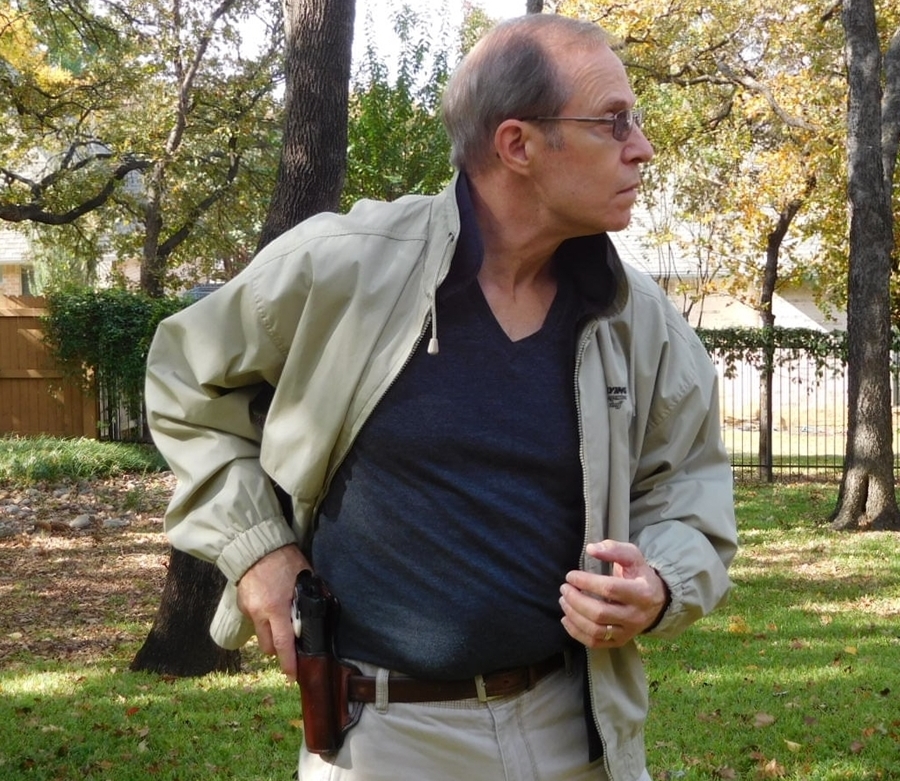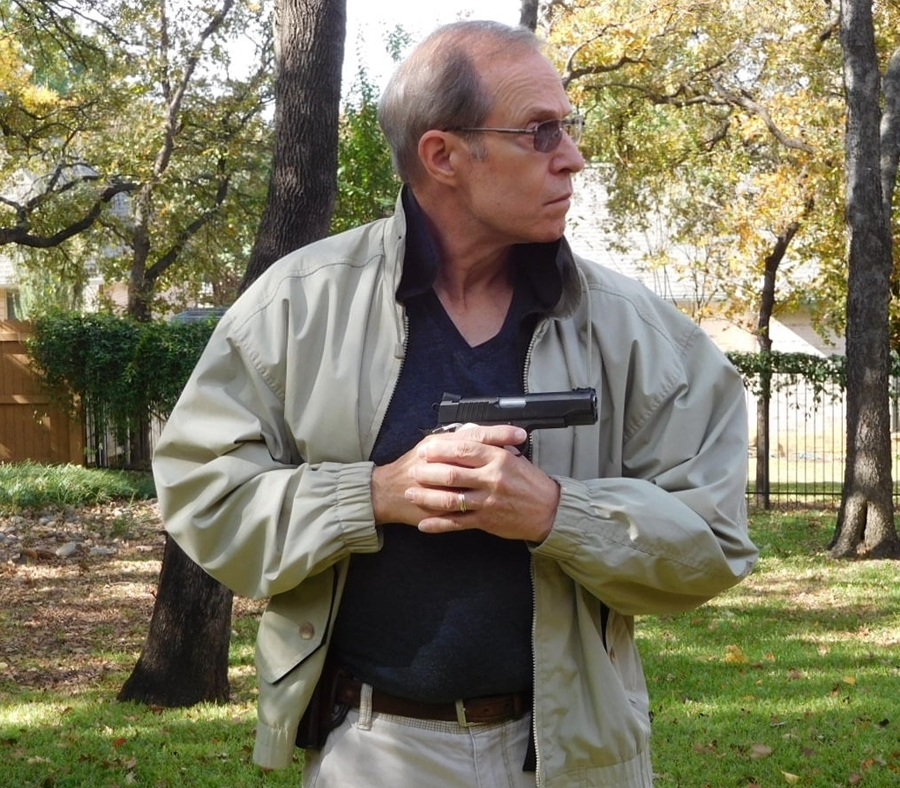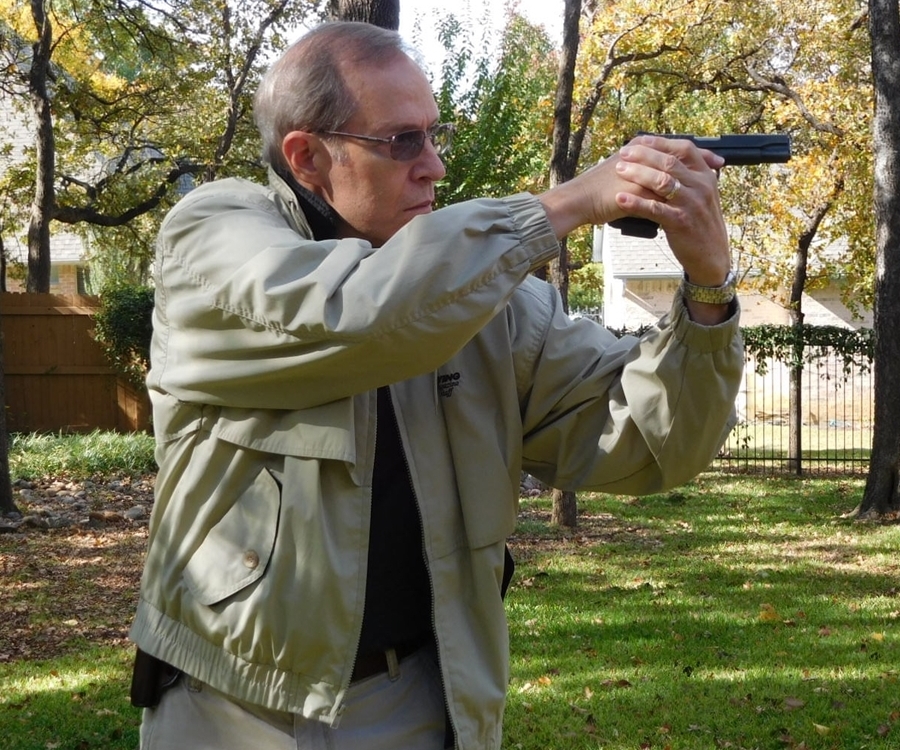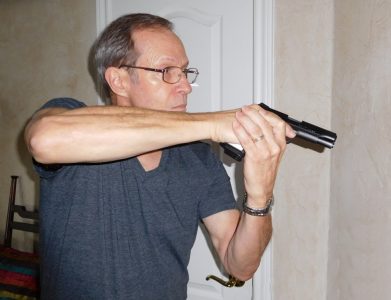
Clearing the covering garment and establishing a grip on the firearm using the Center Axis Relock (CAR) system.
[one_half]

The firearm at the high position parallel with the shoulders and pointing at the target.
[/one_half][one_half_last]

Then roll up to the extended position. This is the primary CAR firing position.
[/one_half_last]
Center Axis Relock
I don’t generally get excited about a new shooting method but Center Axis Relock, or simply CAR, is much more than that. It’s a versatile shooting system that provides a stable firing platform for multiple scenarios and it greatly aids in weapon retention.
Being shot with your own gun is a major concern in real-world self-defense shooting situations and CAR addresses this, while also helping you to quickly and accurately place defensive fire. It got my attention.
In most self-defense situations you start out behind the eight ball since you’re reacting to a threat. Worse case, your assailant has their gun or other weapon ready before you even begin to draw. A fast reaction is necessary and anything that improves your reaction time is a good thing.
If you’ve maintained your situational awareness—you’ve been paying attention to where you are and what’s happening around you—you may not be far behind, but you’re still behind. Through economy of movement that incorporates your body’s natural instincts, Center Axis Relock can help you respond, draw and get on target quickly.
The Fundamentals
Center Axis Relock was developed by Paul Castle who served in law enforcement as a detective and training officer. After retiring he decided to put his experience to work to develop a method to increase the safety and effectiveness of law enforcement and military personnel in close quarters situations. As most self-defense scenarios take place either at short ranges or in confined spaces, the methods he developed for professionals also serve private individuals and concealed-carriers.
In addition to taking advantage of human physical responses, CAR addresses some of the shortcomings of other prominent shooting stances including Weaver and Modern Isosceles. In both of these styles, your arms are either nearly extended or fully extended and many instructors teach shooters to close or partially close one eye to improve sight and target acquisition.
But for many shooters, the difference in perspective between left and right eyes isn’t enough. Your eyes can only focus on objects at one distance at a time, so when you focus on your front sight with both eyes open you see double targets. When you focus on the target as you do when defending yourself against an attacker, you see double sights.
Without strong eye dominance, especially under pressure, it’s possible to pick the wrong sight picture or wrong target. You may have struggled with this in your own shooting; I know I have.
Center Axis Relock keeps your gun close to your body and aligned with a single eye, reducing the unsteadiness caused by fully extended arms, but importantly, it eliminates double vision so that you can quickly get your sight picture and place multiple rounds where they need to go to stop the bad guy.
[one_half]

In the Extended Position, you can use the sights without dealing with a double sight picture or having to close one eye.
[/one_half][one_half_last]

Crossdraw holsters work well with the CAR system. The garment clearing hand remains behind the weapon and is brought to the weapon from underneath.
[/one_half_last][one_half]
From Weaver to Isosceles to CAR
I started shooting handguns with the Weaver stance, with one foot forward and one placed back, using the push-pull grip, but I later adopted Modern Isosceles as it emerged as a more effective stance for tactical situations. With the improved Isosceles stance you stand with both feet planted under your shoulders; you face the target with knees slightly bent, bent forward at the waist and fire with both arms extended in front of you.
The Modern Isosceles is a great position for moving in the open and for maneuvering indoors where you have walls, corners and furniture behind which an adversary can hide. One drawback to the Isosceles is that it presents the full width of your body to your assailant and if you need glasses to see your sights, like I do, the Isosceles position has you looking through the top of your glasses at the sights, not the lower part where your near-vision prescription is. Blurry sights do not help you shoot accurately.
There are two Center Axis Relock primary positions: “high” and “extended.” In both positions you stand bladed to the target; your support-side foot is closer to the target with your weapon-side foot farther away. That puts your shoulders 90 degrees to the target with your support side shoulder pointing directly at it. This offers a smaller target for your attacker. Believe me, when someone’s shooting at you, you want to get very small.
With Center Axis Relock you draw into the high position and bring your gun up to the center of your chest with the barrel level and parallel to your shoulders. If your shoulders are pointing toward your attacker, your gun is also pointing at your attacker and you can quickly fire one or more shots at your attacker’s position if you don’t have time to aim down the sights and he is right on top of you.

Bringing the muzzle down from the Extended position gives you a good room-clearing position. If possible retreat to a safe place, of course, and call law enforcement. But if you must, this is a good position to use while moving through the house.
During the draw, your support hand moves up beneath your gun in your strong hand. It is very important to never sweep your support hand during the draw. In addition, your support hand is pulling your gun away from the target while your gun hand is pushing it toward the target, forming a very stable triangle. This allows you to move in any direction quickly and easily while keeping your attacker covered. You can also use your elbows for elbow strikes if your attacker is that close.
If you have the time and distance from your attacker necessary, you go to the extended position. You smoothly roll the gun up and towards the target. Don’t lower your head to the gun, bring the gun into your line of sight so that the sights are between your eyes and your target. Keeping your head upright helps maintain your balance and allows you to move more freely. The extended position is the intended firing position for accuracy.
The CAR Benefits
- Stability: Holding your weapon close to your body and is more stable than holding your firearms with your arms fully extended
- Eliminates double vision: With the sights held close to your face at reading distance, it eliminates the double sight picture and promotes greater accuracy
- Improves weapon retention: Holding the weapon close to your body makes it more difficult for an attacker to take it away
- Can be used when seated: CAR is the best position when shooting from a car or any other seated position
- Makes a smaller target: By presenting only one side your body to your attacker, it makes you harder to hit
- Reduces recoil: Utilizing the body’s support structure in a natural way reduces felt recoil and helps you stay on target
- Universality: CAR can be used regardless of your age, size, strength or gender
- Speed: With your weapon close to your body, reloading and clearing stoppages is faster
- Instinctive: CAR incorporates your body’s natural reactions
Drawbacks
There are drawbacks to Center Axis Relock. If you enter a room and you don’t know which side the bad guy’s on you may have to turn your entire body to face your target, which takes time you won’t have. The Modern Isosceles stance facilitates faster movement in this kind of situation giving you better reaction time. In an armed encounter, moving off the line between you and your attacker could also help you survive. The Isosceles method is superior to CAR here being more natural for shooting while moving.
What the Professionals Think
My go-to-guy for questions related to training/technique is Steve Krystek, CEO of PFC Training. Steve has twenty-some years experience in military, law enforcement, and security, and has developed tactics for SWAT teams as well as other elite military and law enforcement units.
His school is state-of-the-art with a curriculum that is constantly changing to incorporate the best tactics. I’ve taken half a dozen courses there and can tell you from personal experience that PFC is the best place to really learn armed and unarmed self defense in scenario-based training utilizing the very latest techniques.
When I contacted Steve about Center Axis Relock, I found out that he’d trained with Paul Castle, the developer of CAR. He said that in most situations Modern Isosceles was a superior system overall. His chief instructor, Steve Hartman, mirrored that opinion saying that CAR only serves a narrow niche.
Hartman added that “Every technique can have some merit to it.” In other words, the more you know, the more effective you can be. And the more tools you have in your toolbox, the better prepared you can be for unexpected situations.
Technique is Personal
What’s right for me may not be what’s right for you. I spend a lot of time in my vehicle and like CAR for defending myself from the driver’s seat. I also like it for contact-distance encounters with a single attacker because it provides good weapon retention and the ability to quickly place multiple shots on target.
In addition, I’ve found that the elimination of double vision in the extended position allows me to get my sight picture more quickly and to shoot more accurately at distances of more than 8 to 10 feet. For multiple attackers, I prefer the Modern Isosceles for the ability to cover a wider area with the greatest speed. I’ve also found that I can quickly transition from CAR to Isosceles depending on the situation.
In the course of training more than ten thousand students around the world, the folks at PFC have found the Modern Isosceles to be a more effective method, overall. I can’t argue with that. They’re experts in both tactics and training. But you can only learn what’s most effective for you by training with as many techniques as possible and developing your own personal style. In my opinion, it’s worth some time at the range to see for yourself if it gives you an advantage in self-defense encounters. My bet is that you’ll find that some of these techniques work for you too. The more arrows you have in your quiver, the better.
Center Axis Relock has been around for several years but is starting to make a comeback. Mr. Castle succumbed to cancer four years ago but, thankfully, the company he founded, Sabre Tactical, is carrying on. Sabre Tactical offers an eLearning course you can take at home, which is how I learned the technique.
Live fire is conducted through the Sabre Tactical Associate Program. It’s an easy system to learn but does take practice, especially if you’re accustomed to using a different method.
Keep training and stay safe.
Mr. Lincourt is a U.S. Army combat veteran. He fought in five campaigns and was awarded four medals for heroism. As a lifelong student of close quarters combat, Mr. Lincourt has attended multiple live fire courses in pistol shooting, tactical carbine and shotgun shooting, as well as trained in knife fighting, stick fighting and unarmed defense against guns, knives, and sticks. He is the author of two anti-terrorism thriller novels, “Deadly Deception” and “Death rides the River” and has been writing for GunsAmerica.com for four years.
